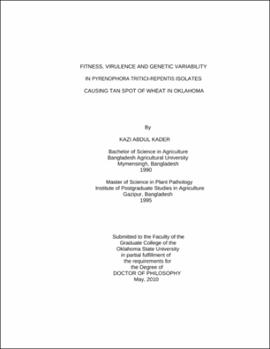| dc.contributor.advisor | Hunger, Robert M. | |
| dc.contributor.author | Kader, Kazi Abdul | |
| dc.date.accessioned | 2013-11-26T08:23:46Z | |
| dc.date.available | 2013-11-26T08:23:46Z | |
| dc.date.issued | 2010-05 | |
| dc.identifier.uri | https://hdl.handle.net/11244/6740 | |
| dc.description.abstract | Scope and Method of Study: Isolates of Pyrenophora tritici-repentis (causal fungus of tan spot of wheat) collected from the 1980s, 1990s and 2000s were studied for their fitness, virulence and genetic relationship. Mycelial growth was quantified on agar media, and sporulation was quantified on agar and on the three wheat cultivars Deliver, TAM 105 and Red Chief. Wheat straw of cv Deliver was infested by each isolate, and total pseudothecia were determined after 14 days of incubation. Maturity of pseudothecia was determined after 23 days of incubation at 15 degrees C. Virulence of isolates was determined by inoculating wheat cultivars with conidia. Three isolates, OKD1, RBB6 and OK-06-1, collected in 1983, 1996 and 2006, respectively, were used in the field study to determine disease severity, yield loss and thousand kernel weight on wheat cv Deliver in 2007-08 and 2008-09. In the greenhouse, the reaction of 11 wheat cultivars was tested to 12 isolates. Race structure and symptom variability was determined by the reaction of wheat cultivars to P. tritici-repentis isolates. Amplified fragment length polymorphism (AFLP) was performed to determined genetic relationship among the isolates. | |
| dc.description.abstract | Findings and Conclusions: Recent isolates collected in the 2000s were more fit for growth, sporulation, pseudothecia formation and maturity than isolates collected in the 1980s and 1990s. The recent isolates also were more virulent than the older isolates. Isolate OK-06-1 (2006) produced significantly more tan spot on wheat in both the years in the field compared to the older isolates OKD1 (1983) and RBB6 (1996). A 25% yield loss was observed for the isolate OK-06-1. Among cultivars, OK-Rising, OK-Field, OK-Bullet and Pete were as resistant as the resistant check Red Chief. All isolates were race 1 except El Reno, which was race 4. Isolates also exhibited variability in symptoms induced of which 56, 32, and 12% were necrosis, necrosis and chlorosis, and chlorosis only, respectively. AFLP studies revealed that the P. tritici-repentis population in Oklahoma did not change significantly over the last three decades and the isolates were likely from a single lineage. | |
| dc.format | application/pdf | |
| dc.language | en_US | |
| dc.rights | Copyright is held by the author who has granted the Oklahoma State University Library the non-exclusive right to share this material in its institutional repository. Contact Digital Library Services at lib-dls@okstate.edu or 405-744-9161 for the permission policy on the use, reproduction or distribution of this material. | |
| dc.title | Fitness, virulence and genetic variability in Pyrenophora tritici-repentis isolates causing tan spot of wheat in Oklahoma | |
| dc.contributor.committeeMember | Payton, Mark E. | |
| dc.contributor.committeeMember | Melouk, Hassan A. | |
| dc.contributor.committeeMember | Edwards, Jeff T. | |
| dc.contributor.committeeMember | Marek, Stephen M. | |
| osu.filename | Kader_okstate_0664D_10770.pdf | |
| osu.accesstype | Open Access | |
| dc.type.genre | Dissertation | |
| dc.type.material | Text | |
| dc.subject.keywords | fitness | |
| dc.subject.keywords | genetic variability | |
| dc.subject.keywords | pyrenophora tritici-repentis | |
| dc.subject.keywords | tan spot | |
| dc.subject.keywords | virulence | |
| dc.subject.keywords | wheat | |
| thesis.degree.discipline | Plant Pathology | |
| thesis.degree.grantor | Oklahoma State University | |
